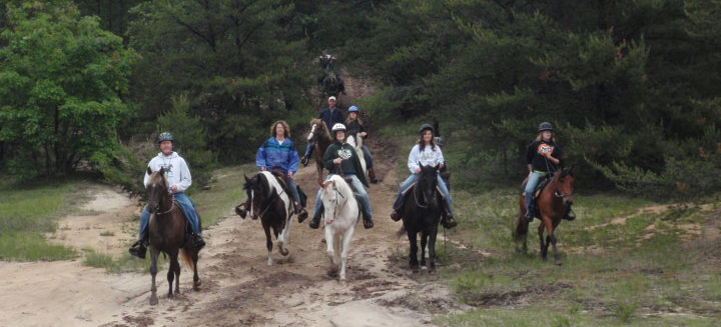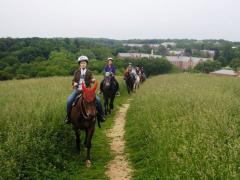
If you’re spending time with your horse on the trail, it’s important to do so responsibly. Below are many ways in which you can be sure that you ride responsibly.
Travel responsibly

- Stay on designated roads, trails and other areas open to horses.
- Ride single file to reduce trail damage. Spread out in open country where there are no trails. Spreading out, rather than following each other’s footsteps, disperses impact and avoids creating a new trail.
- Comply with all signs and respect barriers.
- Riders should match their skill level to the temperament and ability of the horse they ride. Learn more about selecting the appropriate horse for you.
- At trailheads or staging areas, park vehicles and secure horses in a manner that provides a safe distance between the horses and passing traffic.
- Less experienced horses and riders should ride behind more “trail-wise” horses and riders.
- Learn more about safety on the trail.
Respect the rights of others
- Be considerate of others on the road or trail.
- Be prepared to let other trail enthusiasts know what needs to be done to keep you, the horse and other passersby safe when you meet on the trail.
- Be alert and aware of the presence of other trail enthusiasts. If possible, pull to the side of the trail when you hear oncoming off-highway vehicles or bicycles.
- Leave gates as you find them. If crossing private property, be sure to ask permission from the landowner(s).
- Do not disturb historical, archeological or paleontological sites.
- Avoid “spooking” livestock and wildlife you encounter and keep your distance.
- Water animals in areas where stream banks and water access can withstand hard use and are downstream from campsites.
Educate yourself
- Obtain a map of your destination and determine which areas are open to your type of pack animals.
- Make a realistic plan and stick to it. Always tell someone of your travel plans.
- Contact the land manager for area restrictions, closures and permit requirements.
- Check the weather forecast for your destination. Plan clothing, equipment and supplies accordingly.
- Carry a compass or a Global Positioning System (GPS) unit and know how to use it.
- Carry water and emergency supplies even on short trips.
- Keep groups small and carry lightweight gear to reduce the number of animals needed.
- Pre-plan camp locations that provide plenty of room and the proper environment for confining animals.
- Take responsibility for your horse’s education. Introduce it to vehicles and situations it may encounter on shared trails.
Do your part

- Pack out what you pack in. Carry a trash bag and pick up litter left by others.
- Practice minimum impact camping by using established sites and camping 200 ft. from water resources and trails.
- When selecting a campsite, first consider your horses; the site should accommodate them without damaging the area.
- When breaking camp, remove or scatter manure, remove excess hay and straw, and fill areas dug up by animal hooves.
- Observe proper sanitary waste disposal or pack your waste out.
- Bring pellets, grain or weed-free hay to areas where feed is limited or grazing is not allowed. This helps reduce the spread of invasive species.
- Wash your gear and support vehicle and check your animal before and after every ride to avoid the spread of invasive species.
- Build a trail community. Get to know other types of recreationists that share your favorite trail.
Conclusions about trail riding:
- Slowing a horse down on the trail shows control and trust
- Let horse investigate unfamiliar objects – remain patient
- Reward for success
- The more you put your horse in safe situations, the more it will have confidence in you as a rider
- Try to find someone who rides the trails in your area and go with them
- Join or visit a horse organization such as a club or the state horse council and ask for advice on where to ride in your state
- Check out state park websites for horse trails and maps
- Consider you and your horse’s level of experience, the difficulty of the terrain, your horse’s conditioning, etc.
- Add a route with a potable water source so your horse will be able to drink or loop to the trailer if riding all day and there are no potable water sources


